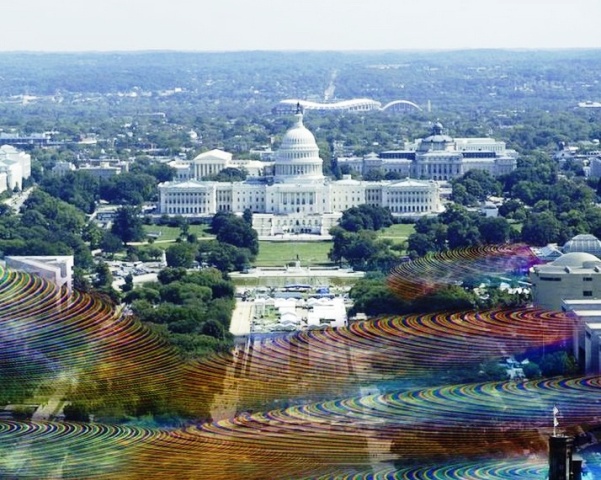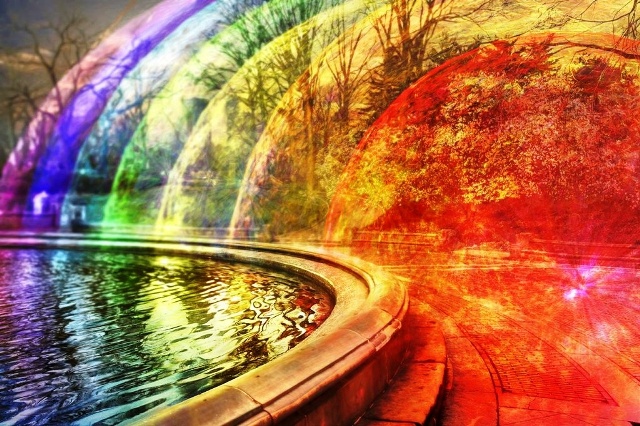
This device can be found almost everywhere; we use it in our homes, in cafes, and now some countries are officially even placing them in areas open to public. WiFi, a modern commodity that we practically rely on, is pretty much an invisible power source that allows us access and explore the internet, connect with our friends and family, and store our data. However, only a few of us have knowledge of exactly what WiFi truly is. So, if we could see WiFi, what would it look like?
An artist and blogger known as Nickolay Lamm, used this question as his inspiration for his artwork. He created visualizations that represent the range, shape, and shades of WiFi impulses if they were visible to the human eye.
To calculate precisely what this would look like, Lamm sought help from M. Browning Vogel, Ph.D., an astrobiologist and past employee at National Aeronautics and Space Administration. Dr. Vogel described the research behind the mobile technology to Lamm, so he could then use the information to create the art.
WiFi is an electric field that is transmissible as waves. The waves possess a certain height, have a precise distance between them, and move at a certain speed. The length between WiFi waves is shorter than that of a radio. Because the radio waves are longer than the microwaves, they have a different band. This ability gives WiFi a distinctive transmission band that can not be interrupted by other signals. WiFi waves tend to be up to three to five inches wide from peak to peak. The height of waves is translated to one by a computer system, and the troughs of the inverted peak is equal a zero. Patterns of these two numbers are interpreted as the letters, numbers and programs that make up online websites, electronic mail, and the extra internet material. Typical WiFi waves decrease in amplitude as they travel further from the source or WiFi router.

The wireless waves travel through empty spaces as rapid, data encoded pulses or waves. When frozen in place, these waves would show that the pulses are about six inches apart. WiFi network routers are basically an antenna that can deliver data at several frequencies at the same time. These multiple frequencies are revealed as red, green, blue, and yellow in the artwork. The data from these various wavelengths can be translated using a typical tag system understood by wireless units.
WiFi consumes the radio frequency band of the electromagnetic spectrum between actual radio waves and of the microwaves used to listen to your radio. However, this frequency of band means that WiFi units and computers can send and receive data as an electro-magnetic wave that has a three to five-inch width distance between each pulse. The WiFi signals are displayed in the artwork as multicolored spheres radiating out from the wave’s origin. WiFi transmitters are fundamentally aerials that are furnished with a transmission protocol that splits the frequency band into many portions, which is also known as channels. Information can be sent over each channel in order to dispatch and receive greater volumes of data at faster rates. WiFi signals are usually rounded, like in the pictures, or oval-shaped and extend to about twenty to thirty meters, assuming that it is a typical in home WiFi router.

This twenty-four-year-old student from Pittsburgh, is focused on using illustrations to bring attention to subjects that are otherwise overlooked, he writes on his website that his work combines artwork and analysis. He also frequently works in collaboration with other artists.
Within the last couple of months, his projects have included a real life visualization of the famous Barbie doll and compares her figure to that of an ordinary female; what a typical person may possibly look like in the next hundred thousand years; and interestingly there is another visualization of cellular networks – which is also a beautiful illustration of artwork. Although Lamm is not the first artist to be inspired by invisible WiFi waves, he is the first to person to incorporate shape and color into the picture. You can find more of his amazing work on his website.
You want to support Anonymous Independent & Investigative News? Please, follow us on Twitter: Follow @AnonymousNewsHQ
This Article (If You Could See WiFi Signals) is free and open source. You have permission to republish this article under a Creative Commons license with attribution to the author and AnonHQ.com.




